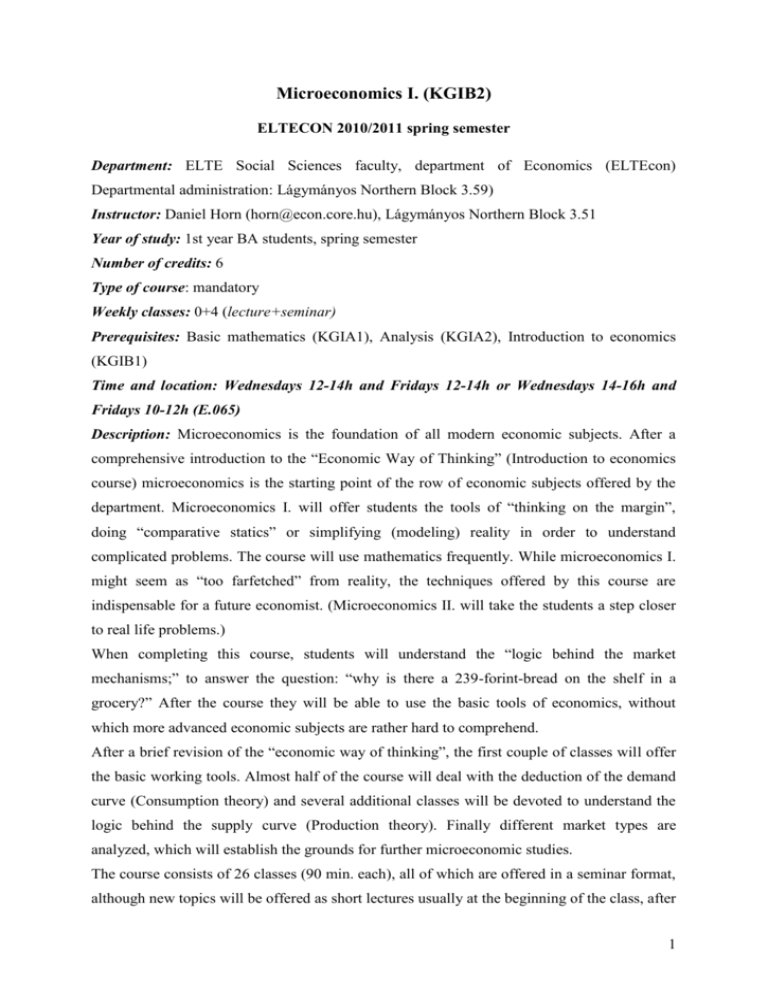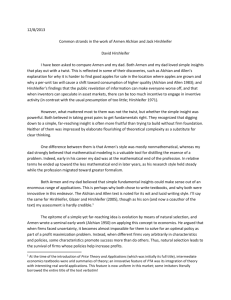microeconomics 1
advertisement

Microeconomics I. (KGIB2) ELTECON 2010/2011 spring semester Department: ELTE Social Sciences faculty, department of Economics (ELTEcon) Departmental administration: Lágymányos Northern Block 3.59) Instructor: Daniel Horn (horn@econ.core.hu), Lágymányos Northern Block 3.51 Year of study: 1st year BA students, spring semester Number of credits: 6 Type of course: mandatory Weekly classes: 0+4 (lecture+seminar) Prerequisites: Basic mathematics (KGIA1), Analysis (KGIA2), Introduction to economics (KGIB1) Time and location: Wednesdays 12-14h and Fridays 12-14h or Wednesdays 14-16h and Fridays 10-12h (E.065) Description: Microeconomics is the foundation of all modern economic subjects. After a comprehensive introduction to the “Economic Way of Thinking” (Introduction to economics course) microeconomics is the starting point of the row of economic subjects offered by the department. Microeconomics I. will offer students the tools of “thinking on the margin”, doing “comparative statics” or simplifying (modeling) reality in order to understand complicated problems. The course will use mathematics frequently. While microeconomics I. might seem as “too farfetched” from reality, the techniques offered by this course are indispensable for a future economist. (Microeconomics II. will take the students a step closer to real life problems.) When completing this course, students will understand the “logic behind the market mechanisms;” to answer the question: “why is there a 239-forint-bread on the shelf in a grocery?” After the course they will be able to use the basic tools of economics, without which more advanced economic subjects are rather hard to comprehend. After a brief revision of the “economic way of thinking”, the first couple of classes will offer the basic working tools. Almost half of the course will deal with the deduction of the demand curve (Consumption theory) and several additional classes will be devoted to understand the logic behind the supply curve (Production theory). Finally different market types are analyzed, which will establish the grounds for further microeconomic studies. The course consists of 26 classes (90 min. each), all of which are offered in a seminar format, although new topics will be offered as short lectures usually at the beginning of the class, after 1 the collection of home assignments. Individual or group based home assignments are given almost every week (except at the mid-term and at the end of the semester exam), and in-class tasks will also be regular. Course content and readings: Book: Jack Hirshleifer, Amihai Glazer, David Hirshleifer (2005): Price theory and applications. 7th edition, Cambridge University press, chapters 1–8, 12. and 13. (henceforth Hirshleifer) Recommended reading and task books: o Hal R. Varian: Intermediate Microeconomics (1999). W. W. Norton & Company; 5th edition o Theodore Bergstrom, Hal R. Varian (2010) Workouts in Intermediate Microeconomics, W. W. Norton & Company; 8th ediction Assessment Home assignments (max 20%): 15 assignments (5 group and 10 individual), each must reach the minimum („acceptable”) level. No points for late assignments. After three late assignment the whole course is failed. All home assignments that are returned for correction, have to be corrected before the end of the semester. Mid-term and final exam (max 40% each, probably on the 8th week and on the last week) – at least 50% must be achieved Mid-term and final exams could be re-taken once. Additional points (max 5%) could be gained by handing in especially hard extra assignments, or writing the group assignments in English. Based on these, all students will be offered a grade, which can be modified by one grade (up or down) on an oral exam. Excellent (5) grades are only given on the oral exam. Limits of offered grades: o 0-50 Fail (1) o 51-64 Satisfactory (2) o 65-74 Average (3) o 75- Good (4) Course content: 2 1st week: 1st class: The nature and scope of economics (revision and systematization of the basic concepts of economics based on the “Introduction to economics” subject) What is microeconomics, Descriptive and normative analysis. Rationality. Scarcity. Individual decision making and societal behavior. Notion of the market. (Hirschleifer, 1st chapter). List of topics to be covered during the semester. 2nd class: Working tools I. Modeling and mathematical models. Variables (endogen variables), parameters (exogenous variables) and the role of functions. The model of supply and demand (mathematical representation, defining and analyzing the equilibrium, comparative static, change in parameters in general and due to government intervention. Taxes, quotas, price ceiling etc.) Mathematical representation and interpretation. (Hirshleifer 2nd chapter) 2nd week: 1st class: Working tools II. The model of supply and demand (contd.) Modeling of different markets (defining a market, isolated markets, relation of markets, difference between the general and the partial equilibrium) Relationship between macro- and microeconomics. (Hirshleifer 2nd chapter) 2nd class: Working tools III. Individual decision based societal behavior Finding an optimum. Average and marginal quantities. (Hirshleifer 2nd chapter) 3rd week: 1st class: Consumer theory I. Preferences (notion of preference ordering, understanding axioms, notion of goods, geometric representation). Representing preferences with utility functions. Ordinal and cardinal utility. Utility function as a multivariable function. Notion, origin and understanding of marginal utility. Notion, origin and understanding of indifference curves and their characteristics. (Hirshleifer 3rd chapter) 2nd class: Consumer theory. Preferences and utility (contd.) Special preferences. Mathematical consequences. Characteristics of goods (classifying goods). Origin of preferences and utility, how we measure them? (Hirshleifer 3rd chapter) 3 4th week: 1st class: Consumer theory III. Consumption optimum. Budget constraint. Role of variables and parameters. A heuristic approach to consumer optimum. Geometric depiction (relation of convexity with necessary and sufficient conditions, problem of corner solutions and their economic interpretation). (Hirshleifer 4th chapter) 2nd class: Consumer theory IV. Conditions for consumer optimum using cardinal or ordinal utility functions. (Hirshleifer 4th chapter) 5th week: 1st class: Consumer theory V. Finding the optimum, multiple methods, “normal” utility curves (Hirshleifer 4th chapter) 2nd class: Consumer theory VI. Finding the optimum, multiple methods, complementary goods and substitutes, other special cases (Hirshleifer 4th chapter) 6th week: 1st class: Consumer theory VII. Individual and market demand. Consumer behavior under changing circumstances. Modeling questions: role of variables and parameters. The Income Expansion Path, the Engel curve, Price Expansion Path, Demand curve (Hirshleifer 4th chapter) 2nd class: Consumer theory VIII. Income and substitution effect of a price change. Problem of decomposition, different approaches. Separation of effects and classification of goods. (Hirshleifer 4th chapter) 7th week: 1st class: Consumer theory IX. Income and substitution effects of price change (contd.). Aggregating individual demands, market demand (Hirshleifer 4th chapter) Demand theory, contd. Notion of elasticity. Income and price elasticity. (Hirshleifer 5th chapter) 4 2nd class: Consumer theory X. Demand curve and elasticity. Classifying goods based on demand. Empirical possibilities of defining a demand curve. Other empirical examples. (Hirshleifer 5th chapter) 8th week: 1st class: Production theory I. Firm as a unit of decision making. Entrepreneur, owner, manager. Microeconomic notion of firm. Profit, revenue and costs. Types of costs, cost curves. (Hirshleifer 6th chapter) 2nd class: Production theory II. The optimal decision of the firm. The shutdown decision. Division of outputs among plants. (Hirshleifer 6th chapter) 9th week: 1st class: Production theory III. Cost functions: short and long run. Effects of economies of scale on the optimal decision. Application: peak and off peak operation. (Hirshleifer 6th chapter). 2nd class: Perfect competition I. Equilibrium on the competitive markets. Supply function on the short and long run. External economies and diseconomies. (Hirshleifer 7th chapter) 10th week: 1st class: Perfect competition II. Equilibrium on the competitive market (contd) Firm survival and the zero profit theorem. Benefit of exchange: consumer and producer surplus. Welfare effects of state interventions: taxes, quotas and price setting (Hirshleifer 7th chapter) 2nd class: Monopoly I. Optimal decision of monopolies. Decision under linear demand. Relation of the optimum and the price-elasticity of demand. Hirshleifer 8th chapter) 11th week. 1st class: Monopoly II. 5 Monopoly vs. perfect competition. Applications. Monopoly and social welfare: analysis of welfare effects. Regulation of monopolies. (Hirshleifer 8th chapter, but chapter 8.4) 2nd class: Demand for factor services and distribution of income I. Demand for factor services. Production and factor employment with a single variable input. The notion of production function. Diminishing returns reconsidered and its relation to the production function. The notion of marginal product. Relation of production functions and cost functions. Relation of cost minimization and profit maximization. Demand for a single factor service. (Hirshleifer 12th chapter) 12th week: 1st class: Demand for factor services and distribution of income II. Production and factor employment with several variable inputs. Multivariate production functions, isoquants, marginal products, geometric representation and function analysis. Finding the optimal input usage. Relation with cost functions. Duality. (Hirshleifer 12th chapter) 2nd class Demand for factor services and distribution of income III. Industry’s demand for inputs. Competitive factor market and monopsony. Welfare questions. Application: labor market and minimum wage regulations. (Hirshleifer 12th chapter) 13th week: 1st class: Demand for factor services and distribution of income IV. Resource supply and factor market equilibrium. Optimum of resource owners. Income and price expansion path on the labor market. Application: the incentive effects of welfare and social security. (Hirshleifer 13th chapter) 2nd class: Demand for factor services and distribution of income V. Individual factor supply and market factor supply. Equilibrium on the factor service market. Application: sources of wage inequalities. (Hirshleifer 13th chapter, except 13.2) Summary. 6









